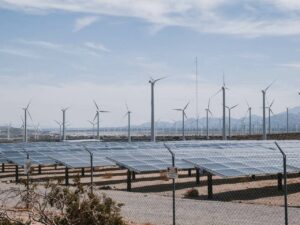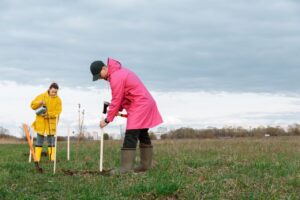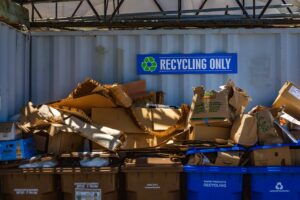Living a sustainable lifestyle isn’t as hard as it seems. With some simple changes and conscious decisions, you can become more eco-friendly, save money, and reduce your impact on the environment. Sustainable living is all about making sure that our current generation doesn’t deplete natural resources for future generations to enjoy.
In this blog post, we will explore how to live a sustainable lifestyle without sacrificing comfort or convenience. From utilizing renewable energy sources to creating an eco-friendly wardrobe, you’ll learn new ways of protecting the planet while still staying stylish. Let’s get started!
Why is living a sustainable lifestyle important?
Living a sustainable lifestyle is increasingly important in our world today. Not only do we need to take care of nature and the environment, but we also need to take responsibility for our consumption habits. Every action we take has an impact on the planet and by living sustainably, we are minimizing our impact and helping ensure a better future for ourselves and generations to come.
Living sustainably means cutting down on waste and preserving natural resources; choosing things that are non-toxic or recyclable when it comes to purchasing items; eating locally-produced food, using alternatives to single-use plastics, and conserving energy whenever possible. It’s about being conscious of our actions as individuals, encouraging others to do the same, and striving towards a green lifestyle that’s beneficial for everyone.
How can we live a sustainable life?
Living a sustainable life is more important than ever before, and thankfully, it does not have to be difficult. The best thing we can do for the environment is to simply change our everyday habits.
Reducing food waste and eating locally are great ways to start – by buying from farmers’ markets or local produce stands, we can cut down on the energy used to make, transport, and package products from farther away locations.
Additionally, buying items second-hand helps reduce our material consumption and prevents perfectly good items from entering landfills needlessly. Also, cutting back on fossil fuels by implementing renewable energy systems in our homes and workplaces will drastically reduce our carbon footprint.
How do you transition to a sustainable lifestyle?
Adopting a sustainable lifestyle can be a daunting task, but the payoff is huge! Sustainable living practices can help preserve our planet and its resources for future generations. The key to transitioning to a sustainable lifestyle is to take small steps.
Consider committing to one of the three Rs – reduce, reuse, recycle – and start with that. For example, you could shift your daily habits and use reusable shopping bags instead of single-use plastic ones or bring your coffee mug every morning to avoid using disposable cups. Every little effort adds up and makes a difference!
Additionally, try replacing energy-hungry appliances with energy-efficient alternatives; pay attention when grocery shopping and opt for products with minimal packaging or look for locally sourced items; and choose wisely when it comes to home furnishings such as furniture, rugs, and appliances. Taking the initiative to make small changes in our daily routines can have an immense effect on the environment, so why not give it a try?

How can I start sustainable living at home?
Making changes to your every day habits can have a major impact on the environment, making it easier than ever to get started with sustainable living at home. After all, small acts done by many can make a big difference! A great place to start is in the kitchen.
Buy products with minimal packaging and prioritize fresh, locally sourced ingredients when possible. For bigger changes, switch up your home’s energy sources, such as using solar panels or investing in energy-efficient appliances.
Lastly, reducing water consumption is an important step toward sustainability; consider installing some sort of collection system for rainwater that can be reused for the garden or other activities like cleaning car windows and sidewalks. With a few conscious lifestyle adjustments, you’ll be well on your way to creating a sustainable living space.
How can a beginner be sustainable?
Being sustainable as a beginner can feel daunting, but there are lots of easy ways to get started. Begin by educating yourself about the issues and try to think about your daily habits and lifestyle.
For example, take little steps like cutting back on single-use plastics and energy consumption. You could also look at recycling options for your household items and invest in reusable containers for lunches or travel.
Walk or bike instead of driving whenever possible, and minimize your waste production as much as you can by reducing the amount you buy that’s packaged in unrecyclable materials. As long as you allow yourself to learn and adjust along the way, sustainability is easily within reach!
What is the most sustainable lifestyle?
Living a sustainable lifestyle is all about making responsible choices to reduce your environmental impact. This can take many forms, from simple things like recycling and eating locally-sourced food to larger behavioral changes, such as cutting down on mobile phone and credit card use or taking public transit instead of driving.
Making conscious decisions about conserving natural resources and mindfully reducing waste, regardless of scale, is the key. Living a sustainable lifestyle will always be a journey rather than a destination; balancing both long-term sustainability goals with short-term convenience is an important part of the process.

Summary
Overall, living a sustainable lifestyle is rewarding and beneficial in so many ways. Not only are you helping the environment, but you’re also protecting your health as well as that of others.
Whether it’s eating organic food, investing in eco-friendly transportation, or shopping responsibly, improving your sustainability practices is an essential step toward creating a brighter future for us all. It can seem daunting at first, but taking small steps and being mindful of the way we live our lives can make a big impact.
Even little things such as reusing plastic containers and bags go a long way in helping to reduce our carbon footprint and make the planet more habitable for generations to come. We have the power to make positive changes that will last; let’s use it!




